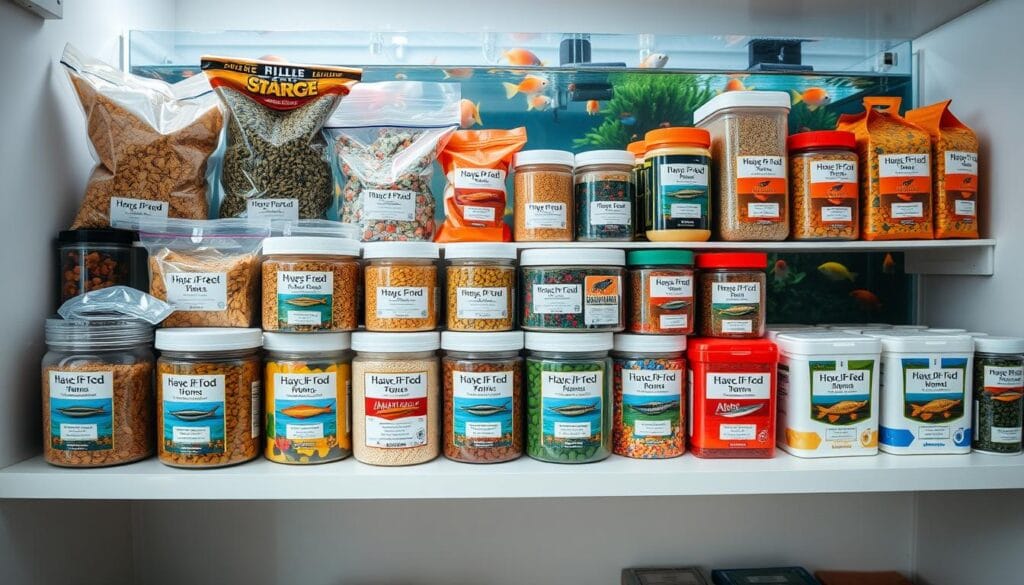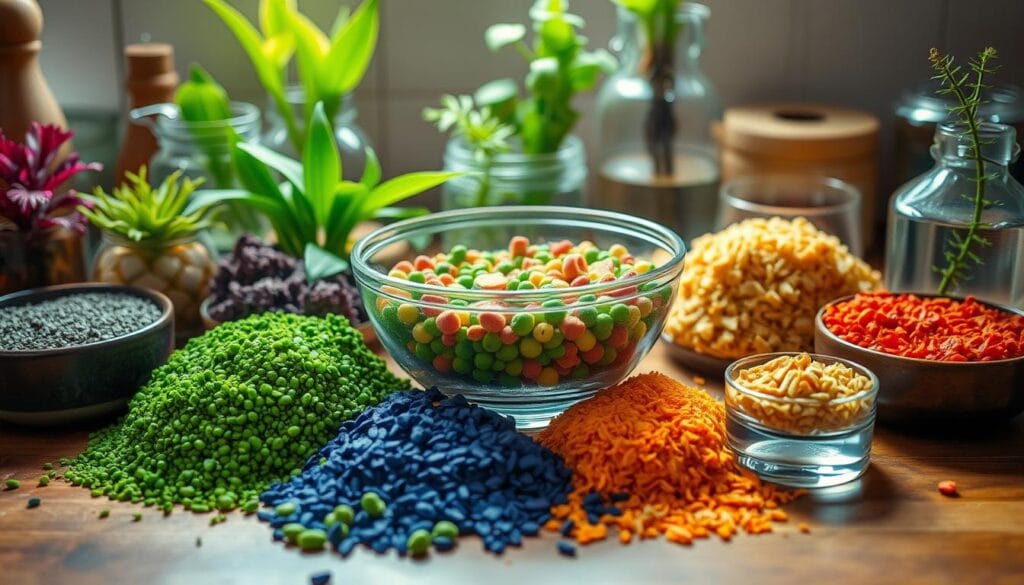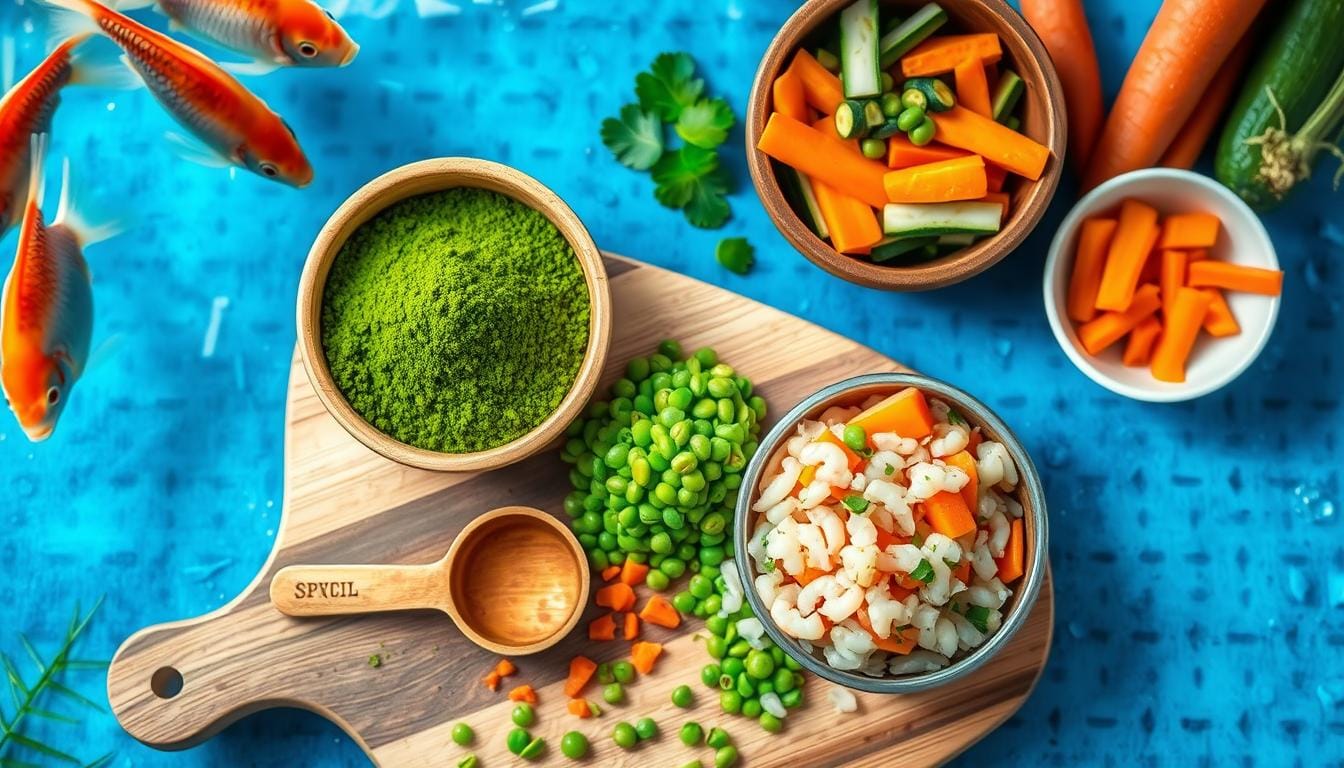Fish Food Recipe That Will Make Your Fish Thrive
As a fish owner, you want the best for your aquatic pets. This includes a nutritious and delicious meal. A good fish food recipe should have protein, fat, and carbohydrates. You can make a homemade recipe using canned salmon, which is full of protein and omega-3 fatty acids.
Making your own fish food is fun and rewarding. It lets you control the ingredients and avoid harmful additives in commercial products. You can tailor the diet to your fish’s needs, whether they eat meat, plants, or both. A flexible recipe with ingredients like fish, shrimp, and peas can provide a balanced diet.
Making DIY fish food saves money and is good for the environment. Homemade recipes are cheaper than store-bought food. With a little creativity, you can make a recipe that meets your fish’s unique needs. The goal is to give them a diet rich in proteins, vitamins, minerals, and fats.
Table of Contents
Understanding the Importance of Proper Fish Nutrition
When you start caring for fish, it’s key to give them a balanced diet. A diet full of protein, fat, and carbs is crucial for their health. Choosing the right fish food ingredients is important, and making your own can be a good choice.
Knowing what your fish needs helps you pick the right food. Some fish need more protein, while others need fiber. By picking the right ingredients, you can avoid nutritional problems and keep your fish happy and healthy.
Feeding your fish well can make them grow faster, look better, and stay healthy. By picking the right ingredients and making your own food, you can help your fish live a long, healthy life. Whether you’re new to fish care or have been doing it for years, understanding nutrition is key. Using healthy food and making your own can really help.
Required Equipment for Making Fish Food at Home
To make fish food at home, you need some basic tools. You’ll need a blender, a mixing bowl, and a freezer. These tools help you make easy fish food recipes that are good for your fish.
A blender is key for mixing ingredients like fish meal and spirulina. You also need a mixing bowl to combine these ingredients. And, you must have a freezer to store the fish food.
Here is a list of the required equipment:
- Blender
- Mixing bowl
- Freezer
Using the right tools makes it easy to make a simple fish food recipe. Just follow a few steps and use the right ingredients. This way, you can give your fish a healthy and balanced diet.
Always use fresh and high-quality ingredients for the best results. With the right tools and ingredients, you can make a tasty and nutritious fish food recipe. Your fish will love it.
| Equipment | Description |
|---|---|
| Blender | Used for mixing ingredients |
| Mixing bowl | Used for combining ingredients |
| Freezer | Used for storing finished fish food |
Essential Ingredients for Your Fish Food Recipe
Choosing the right ingredients is key to making the best fish food. You want your fish to get all the nutrients they need for health and growth. The right mix of ingredients can greatly improve your fish’s well-being.
To make a balanced fish food, you’ll need different types of ingredients. These include protein sources, vegetables, and vitamins and minerals. For protein, you can use fish meal and krill meal. Vegetables like spirulina and peas add fiber and other nutrients.
Protein Sources
Protein is vital for fish growth and energy. Good protein sources are fish, shrimp, earthworms, and egg yolks. You can also use fish food protein powders.
Vegetable Components
Vitamins and minerals are crucial for fish health. You can find them in vegetables like spinach, peas, and zucchini. Add these fresh or frozen to your recipe.
Vitamin and Mineral Supplements
Adding vitamin and mineral supplements is important. They ensure your fish get all the nutrients they need. Use garlic-free supplements like vitamin C and vitamin E.
Here’s a list of essential ingredients for your fish food:
- 2 oz of frozen spinach
- 1 oz of grated carrots
- 1 oz of fish meal
- 1 oz of krill meal
- 1/4 teaspoon of vitamin C supplement
- 1/4 teaspoon of vitamin E supplement
Using these ingredients and a balanced recipe, you can feed your fish well. Always research your fish’s specific dietary needs to ensure the best care.
Step-by-Step Fish Food Recipe for Beginners
To make a simple fish food recipe, you need a few basic ingredients. These include fish meal, krill meal, and spirulina. They give your fish the protein, vitamins, and minerals they need.
You can also add peas and carrots to make the recipe more complex. This adds variety and nutrients to your fish’s diet.
A basic recipe for beginners is 1 oz of fish meal, 1 oz of krill meal, and 1 oz of spirulina. Mix these together with water to make a paste. This recipe is a good start, and you can change it as your fish’s needs change.
Here’s how to make this easy fish food recipe:
- Mix 1 oz of fish meal, 1 oz of krill meal, and 1 oz of spirulina in a bowl.
- Add 1-2 tablespoons of water and stir until it’s a paste.
- Feed your fish 2-3 times a day, only as much as they can eat in a few minutes.
Always use fresh, high-quality ingredients for your fish. Adjust the recipe as needed to keep your fish healthy and happy. With this simple recipe, you can make a nutritious meal for your fish and enjoy a thriving aquarium.
| Ingredient | Quantity | Nutritional Value |
|---|---|---|
| Fish Meal | 1 oz | High in protein and omega-3 fatty acids |
| Krill Meal | 1 oz | Rich in antioxidants and astaxanthin |
| Spirulina | 1 oz | High in vitamins and minerals, including iron and calcium |
Customizing Your Recipe for Different Fish Species
Exploring fish food for tropical fish shows that each species has its own needs. To make the best fish food, you must think about these differences. Tropical fish need lots of protein and fat, while cold water fish prefer carbs.
To tailor your recipe, focus on what your fish need. Add more protein like fish meal and krill meal for tropical fish. Here are some tips to start:
- Research the specific nutritional needs of your fish species
- Adjust the ingredient ratios to meet those needs
- Consider adding supplements or vitamins to enhance the nutritional value
Customizing your recipe ensures your fish get what they need to thrive. This is true for both tropical and cold water fish. The goal is to give them a balanced, nutritious diet.
| Fish Species | Dietary Needs |
|---|---|
| Tropical Fish | High protein, high fat |
| Cold Water Fish | High carbohydrates, moderate protein |
The best fish food recipe is one that fits your fish’s needs. By researching and customizing, you can make a healthy diet for your fish.
Proper Storage and Preservation Methods
Proper storage and preservation are key for diy fish food. Store your homemade fish food in airtight containers in the freezer. This keeps moisture and contaminants out, keeping the food quality high. Freezing and refrigeration help prevent spoilage and keep the nutrients in fish food ingredients.
To keep your diy fish food fresh, follow storage guidelines. Store it in the fridge for up to two days if you’ll eat it soon. But for longer storage, freezing is best. Wrap the food in plastic wrap before putting it in freezer bags to keep it fresh.

- Store fish food in airtight containers to prevent moisture and contamination.
- Keep fish food in the refrigerator at a temperature of 40°F (4°C) or below.
- Freeze fish food at 0°F (-18°C) or below to maintain nutritional value.
By using these storage and preservation methods, your diy fish food stays fresh and safe for your fish. Always handle and store fish food ingredients safely to avoid foodborne illness.
Signs Your Homemade Fish Food is Working
Switching to homemade fish food can show clear signs of success. Your fish might look healthier and act differently. They could have shiny scales, clear eyes, and a big appetite. This means they’re getting the nutrients they need from your homemade recipe.
Some key indicators of success include:
- Improved appetite and increased activity levels
- Shiny scales and clear eyes
- Robust growth and development
By watching for these signs, you can tweak your recipe. This ensures your fish stay healthy and happy. Always use the best recipe for your fish’s needs. And don’t be afraid to make changes to keep them well.
Following these tips and using a balanced recipe can make your fish happy and healthy. They’ll thrive and live a long, joyful life.
| Signs of Success | Description |
|---|---|
| Improved Appetite | Increased interest in food, eating enthusiastically |
| Shiny Scales | Healthy, vibrant scales that reflect light |
| Clear Eyes | Bright, clear eyes that are free of cloudiness or disease |
Common Mistakes to Avoid When Making Fish Food
When making your own fish food, it’s key to avoid mistakes that can hurt your fish. One big error is using low-quality ingredients. This can cause nutritional problems and health issues. So, pick high-quality ingredients like fresh fish meal and krill meal for your recipe.
Another mistake is overfeeding, which can lead to digestive problems and bad water quality. Watch how much you feed your fish to avoid this. Also, make sure your recipe has a mix of ingredients to give your fish all the nutrients they need.
Some common mistakes to avoid when making fish food include:
- Using low-quality ingredients
- Overfeeding
- Not providing a balanced diet
By avoiding these mistakes, you can make a healthy and nutritious fish food recipe. This will help your fish stay healthy and happy.
Creating a well-thought-out fish food recipe is crucial for your fish’s health. By planning a balanced and nutritious diet, you can help your fish live a long and healthy life.
| Ingredient | Benefits |
|---|---|
| Fish meal | High-quality protein source |
| Krill meal | Rich in omega-3 fatty acids |
| Vegetables | Provide essential vitamins and minerals |
Cost Comparison: Homemade vs Commercial Fish Food
Many think commercial fish food is cheaper. But, making your own can save you a lot of money. Using fresh ingredients and making big batches can cut costs by up to 50%.
Starting to make your own fish food might seem pricey at first. But, the savings over time are huge. Buying ingredients in bulk and making lots of food helps save money.
Initial Investment Analysis
Starting to make homemade fish food costs money for equipment and ingredients. But, these costs are worth it for the long-term savings. You can buy ingredients in bulk and make lots of food to save money.
Long-term Savings Breakdown
Homemade fish food saves you money and ensures your fish get the nutrients they need. You can also tailor the recipe to your fish’s specific needs. This can improve their health and happiness.

Plus, making your own fish food gives you peace of mind. You can choose the best ingredients for your fish. With some planning, you can make a nutritious and affordable fish food recipe.
Tips for Transitioning Fish to Homemade Food
When you start feeding your fish homemade food, do it slowly. Mix a little homemade food with their usual food and slowly add more homemade food. This helps your fish get used to the new food without upset stomachs. A good homemade food recipe is a great place to start, as it has all the nutrients your fish need.
You can also change a simple fish food recipe to fit your fish’s needs. You can add or take away ingredients based on what your fish likes or needs. Always watch how your fish reacts to the new food. This way, you can make sure they are doing well on their new diet.
- Start with small amounts of homemade food and gradually increase the proportion
- Monitor your fish’s response to the new diet, watching for signs of stress or digestive issues
- Customize the recipe to meet the specific needs of your fish
- Ensure the homemade food is nutritionally balanced and provides all the necessary nutrients for your fish
| Ingredient | Quantity | Nutritional Value |
|---|---|---|
| Fish meal | 1 cup | High-quality protein source |
| Vegetables | 1/2 cup | Rich in fiber and vitamins |
| Vitamin and mineral supplements | 1 tablespoon | Essential for immune function and overall health |
By following these tips and using a simple fish food recipe, you can make the switch to homemade food smooth for your fish.
Seasonal Adjustments to Your Fish Food Recipe
As the seasons change, your fish’s needs may shift. To keep your fish healthy, adjust your fish food recipe seasonally. For example, add more protein during breeding season to support reproductive health. Young fish need 40-50% protein, while adults do well with 30-40%.
A good homemade fish food mix has protein, carbs, and vitamins and minerals. Carnivores eat fishmeal, shrimp, and other animal products. Herbivores get protein from spirulina and soy meal. Carbs come from rice, wheat, and algae. Vitamins like C, D, E, and B vitamins are key, along with minerals like calcium and iron.
Here are tips for seasonal fish food recipe changes:
- Add more protein sources during the breeding season to support reproductive health
- Increase carbohydrate sources during the winter months to support energy needs
- Use organic produce to avoid harmful pesticides
- Avoid toxic ingredients like garlic, onions, and highly processed foods
Seasonal changes to your homemade fish food recipe can help your fish thrive. Use fresh, high-quality ingredients. And remember, don’t overfeed or underfeed your fish.
| Season | Protein Sources | Carbohydrate Sources |
|---|---|---|
| Breeding Season | Fishmeal, shrimp, spirulina | Rice, wheat, algae |
| Winter Months | Fishmeal, soy meal, shrimp | Rice, wheat, oats |
Conclusion
Making your own fish food at home is rewarding for you and your fish. By using the recipes and tips from this guide, you can give your fish a healthy diet. This diet supports their health and energy. It’s also cost-effective and lets you choose ingredients for your fish’s needs.
Ingredients like spirulina powder and unflavored gelatin are easy to find and mix. This makes a food rich in nutrients for your fish. With a bit of effort, you’ll see your fish doing well on your homemade food. Keep trying new recipes and adjust them with the seasons to keep your fish healthy all year.
Starting or adding homemade fish food to your aquarium is a great choice. It’s a fun and rewarding part of caring for your fish. Enjoy making it and be proud to give your fish the best food for their health and happiness.
FAQ
What are the essential nutrients for healthy fish?
Healthy fish need protein, fat, and carbs. A balanced diet with these nutrients helps them thrive.
What equipment is needed for making fish food at home?
You’ll need a blender, a mixing bowl, and a freezer to make fish food at home.
What are the best protein sources for a homemade fish food recipe?
Fish meal and krill meal are key for fish growth and development.
How can I customize my fish food recipe for different fish species?
Tailor your recipe to meet the nutritional needs of your fish. Tropical fish need more protein, while cold water fish need carbs.
How should I store and preserve homemade fish food?
Freeze or refrigerate your homemade fish food to keep it fresh and safe.
What are the signs that my homemade fish food is working?
Look for shiny scales, clear eyes, and a strong appetite. These signs show your fish are doing well.
What are the common mistakes to avoid when making fish food at home?
Don’t use low-quality ingredients, overfeed, or skip a balanced diet. These mistakes can harm your fish.
Is homemade fish food more cost-effective than commercial options?
Yes, homemade fish food can save money. It’s cheaper in the long run, even with initial costs.
How do I transition my fish to a homemade diet?
Start by adding a little homemade food to their diet. Watch how they react to ensure a smooth transition.
Should I adjust my fish food recipe seasonally?
Yes, adjust your recipe seasonally. Add more protein in breeding season and more carbs in winter.

